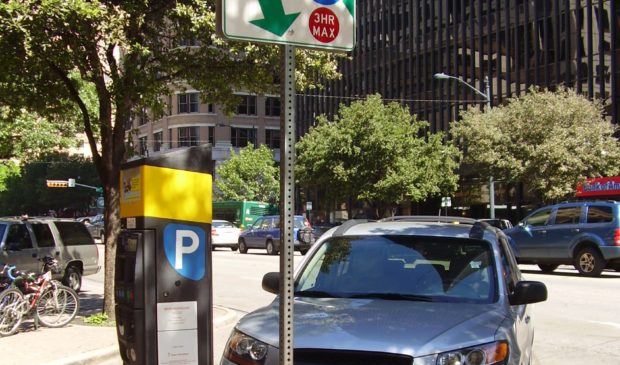Parking price jump almost certain as study heads to city officials
Tuesday, April 11, 2017 by
Chad Swiatecki Increased pricing for street-front parking is almost a certainty in downtown Austin’s near future.
That tactic was one of more than a dozen recommended by a consulting firm tasked with solving the parking crunch that plagues many areas of Austin’s downtown core almost daily.
The plan from San Francisco-based Nelson\Nygaard Consulting Associates also calls for partnerships between private lot and garage owners, use of technology to find available parking, eliminating parking minimums for new construction, improving transit and shuttle service and eventually adding to the downtown parking supply.
The Downtown Austin Alliance-commissioned plan is partially intended to improve the churn rate on parking downtown so that at least 15 percent of the 71,500 spaces in the core – the area bordered by Lamar Boulevard, Martin Luther King Boulevard, I-35 and Cesar Chavez Street – are available at all times.
Last week’s unveiling of the plan contained recommendations likely to be considered by City Council in the future, and jointly considered by city and business leaders to divide various recommendations before the beginning of its implementation.
Among the firm’s findings:
Underutilization of parking in the west and southwest sections of downtown, as well as portions of the eastern border, create a demand crunch elsewhere
Off-street and garage parking spaces are habitually underused
Price gaps between cheap but scarce street-front parking and costly spots in nearby garages create traffic congestion from drivers looking for a deal
Poor enforcement of time limits lend to desirable parking spots routinely being used for more than half a day by one vehicle
Inconsistent signage and pricing on garages and paid lots makes it difficult for drivers to find new parking options
_
Business owners and others at the plan’s unveiling expressed doubt and some resistance to measures they said could make it harder for customers and business contacts to park nearby.
“This is one of the strangest and most emotional topics in cities, and it’s tied to both affordability and economic development,” said Jeff Tumlin, director of strategy for Nelson\Nygaard. “The data we have is clear, that there’s plenty of parking available. It’s a question of where it is, and how to manage that supply.”
The firm, which has also studied parking systems in Boulder, Colorado, Nashville and Seattle, favors creating an entity within city government to set parking rates rather than having Council itself make those decisions. Tumlin pointed to Seattle’s practice of continually monitoring parking use and making pricing adjustments quarterly to balance out demand in various sectors.
One key move that emerged throughout the presentation is the need for a public or private entity to take the lead in pushing for the plan’s adoption in whole.
That leadership will be needed to try to marshal agreements or collaborations on pricing and enforcement with private entities that manage parking assorted inventories in different parts of downtown.
Tumlin pointed to both government-led or entirely private partnerships to manage parking inventory that have been successful in cities such as San Diego and Sacramento.
Dewitt Peart, president CEO of the Downtown Austin Alliance, said his group plans to form a parking group with city and Capital Metropolitan Transportation Authority officials in the next six months to divide responsibility of the plan’s components.
“This is a demonstration of where Austin is headed, which is more urbanized, and we can’t ignore the reality of what needs to be done,” he said. “A big part of this when we commissioned it last year was getting a parking inventory and using that while we look at the future development plans and what will be needed.”
Download (PDF, 7.44MB)
This story has been corrected. We originally reported that the plan would be considered for adoption by the city when, in fact, only portions of it will be up for consideration, not the plan as a whole. Photo by WhisperToMe (Own work) [Public domain], via Wikimedia Commons.
The Austin Monitor’s work is made possible by donations from the community. Though our reporting covers donors from time to time, we are careful to keep business and editorial efforts separate while maintaining transparency. A complete list of donors is available here, and our code of ethics is explained here.
You're a community leader
And we’re honored you look to us for serious, in-depth news. You know a strong community needs local and dedicated watchdog reporting. We’re here for you and that won’t change. Now will you take the powerful next step and support our nonprofit news organization?









